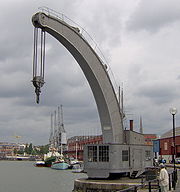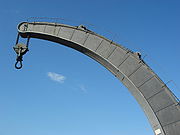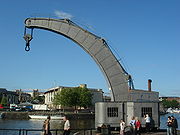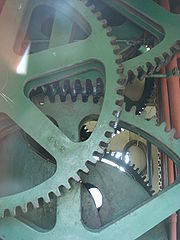
Fairbairn steam crane
Encyclopedia





Crane (machine)
A crane is a type of machine, generally equipped with a hoist, wire ropes or chains, and sheaves, that can be used both to lift and lower materials and to move them horizontally. It uses one or more simple machines to create mechanical advantage and thus move loads beyond the normal capability of...
of an 'improved design', patented in 1850 by Sir William Fairbairn
William Fairbairn
Sir William Fairbairn, 1st Baronet was a Scottish civil engineer, structural engineer and shipbuilder.-Early career:...
. There is one surviving example in Bristol Docks, England.
Innovative design
The crane's innovation was in the use of a curved jibJib
A jib is a triangular staysail set ahead of the foremast of a sailing vessel. Its tack is fixed to the bowsprit, to the bow, or to the deck between the bowsprit and the foremost mast...
, made of riveted wrought iron
Wrought iron
thumb|The [[Eiffel tower]] is constructed from [[puddle iron]], a form of wrought ironWrought iron is an iron alloy with a very low carbon...
platework to form a square-section box girder
Box girder
A box or tubular girder is a girder that forms an enclosed tube with multiple walls, rather than an or H-beam. Originally constructed of riveted wrought iron, they are now found in rolled or welded steel, aluminium extrusions or pre-stressed concrete....
. This curved jib could reach further into the hold of a ship, clear of the deep gunwales alongside the quay.
Designing a strong curved jib required Fairbairn's advanced theoretical understanding of the mechanics of a box girder. The tension forces were carried by the outer, convex surface of the girder which was made of these back plates being chain-riveted together. The inner surface carried a compressive load. To avoid this cell plate crumpling, it was made as a cellular structure: an inner plate and webs formed three rectangular cells, effectively box girders in their own right. The character of a box girder is to resist torsional twisting, so a composite face built up of them is also good at resisting crumpling.
The first of these cranes were a batch of six built for the Admiralty
Admiralty
The Admiralty was formerly the authority in the Kingdom of England, and later in the United Kingdom, responsible for the command of the Royal Navy...
at Keyham and Devonport
HMNB Devonport
Her Majesty's Naval Base Devonport , is one of three operating bases in the United Kingdom for the Royal Navy . HMNB Devonport is located in Devonport, in the west of the city of Plymouth in Devon, England...
. These were hand-operated and could lift 12 tons to a height of 30 feet (9.1 m) and a radius of 32 feet (9.8 m) . The size of the crane jibs was determined by ships of the period, and their lifting capacity by men's ability to raise the load. Experiments at Keyham with loads of up to 20 tons showed the jib design to be sound, and that the jib at least was capable of handling loads of up to 60 tons.
A "colossal" crane of 60 tons was later built at Keyham, with a cell plate stiffened by four cells. This crane was worked by four men driving through a gear train of 632 times, which must have been hard and slow work at full capacity. As the capacity of the crane was so obviously limited by its motive power, not its strength, they were an obvious candidate for steam power - as was later re-applied to the 60 ton crane at Keysham. There was even a proposal for a 120 feet (36.6 m) high crane, to replace masting sheer
Masting sheer
A masting sheer, sheers, shears or masting crane is a specialised shipyard crane, intended for placing tall masts onto large sailing ships...
s at Woolwich
Woolwich Dockyard
Woolwich Dockyard was an English naval dockyard founded by King Henry VIII in 1512 to build his flagship Henri Grâce à Dieu , the largest ship of its day....
. A more typical size for most of these later cranes though would be able to lift 35 tons at a radius of 35 feet (10.7 m). They were powered by self-contained steam engine
Steam engine
A steam engine is a heat engine that performs mechanical work using steam as its working fluid.Steam engines are external combustion engines, where the working fluid is separate from the combustion products. Non-combustion heat sources such as solar power, nuclear power or geothermal energy may be...
s, with both boiler
Boiler
A boiler is a closed vessel in which water or other fluid is heated. The heated or vaporized fluid exits the boiler for use in various processes or heating applications.-Materials:...
and engine mounted on-board the crane.
William Fairbairn & Sons
William Fairbairn & Sons
William Fairbairn and Sons, was an engineering works in Manchester, England.-History:William Fairbairn opened an iron foundry in 1816 and was joined the following year by a Mr. Lillie, and the firm became known as Fairbairn and Lillie Engine Makers, producing iron steamboats.Their foundry and...
of Manchester built a number of these cranes and also licensed the design to other makers.
Bristol
The only surviving Fairbairn steam crane is in Bristol, on the quayside at the site of the Mshed museum on Bristol dockside.Construction
In the 1870s, Bristol Docks was going through a period of expansion. Iron-hulled ships were becoming larger, cargoes heavier, and there had already been investment in building a railway line along the harbour quay. Crane capacity was limited though – none of the harbour's 17 cranes being able to lift more than 3 tons.Accordingly a more powerful steam crane
Steam crane
A steam crane is a crane powered by a steam engine. It may be fixed or mobile and, if mobile, it may run on rail tracks, caterpillar tracks, road wheels, or be mounted on a barge...
was ordered, to be capable of lifting 35 tons and loading it directly onto a railway wagon. This was ordered from local makers Stothert & Pitt
Stothert & Pitt
Stothert & Pitt were a British engineering company founded in 1785 in Bath, England. They were the builders of a variety of engineering products ranging from Dock cranes to construction plant and household cast iron items. They went out of business in 1989...
in 1875, although to the Fairbairn pattern. As for the later Fairbairn cranes, the original cell plate was changed to a design of a single flat plate stiffened by riveted T section ribs, rather than the original cellular structure. In August 1878 the crane had been completed and tested, at a cost of £3,600 for the machinery, plus the masonry foundations.
The jib has a radius (reach) of 35 feet (10.7 m) and a height of 40 feet (12.2 m). The crane weighs 120 tons. A vertical boiler
Vertical boiler
A vertical boiler is a type of fire-tube or water-tube boiler where the boiler barrel is oriented vertically instead of the more common horizontal orientation...
inside the cab operates at 100 psi and supplies two twin-cylinder steam engines: one for slewing (turning) the crane, a larger one for winding the lifting chain. The winding drums can be driven by their gearing at four different speeds. To stop the crane toppling sideways, it is anchored by a tubular iron column running down into a well 15 feet (4.6 m) below the crane. Roller bearings beneath the cab carry the weight and a plain bearing at the foot of the well resists tipping loads. Water for the boiler is supplied by a pump, which originally drew water straight from the dock and is also used for draining the well. The boiler's maker's plate reads "Marshall Sons & Co. Ltd.
Marshall, Sons & Co.
-External links:* – at the Powerhouse Museum, Sydney, Australia...
, Engineers, Gainsboro
Gainsborough, Lincolnshire
Gainsborough is a town 15 miles north-west of Lincoln on the River Trent within the West Lindsey district of Lincolnshire, England. At one time it served as an important port with trade downstream to Hull, and was the most inland in England, being more than 55 miles from the North...
, England, No.92766".
The cab of the crane is also of iron, with small-paned windows. Some time around 1900 the winding drums and their gears were enclosed in a further box on the roof. These window frames are decorated with small roses case into the junctions of the glazing bars.
In service
Although mechanically capable, the crane was not a great success commercially. In 1890 it was only used for 16 days of the year, for a profit of just 11s. 6d. Ships had increased in size by this time and the jib could no longer reach far enough to remove engines or boilers for repair work. It was even considered raising the crane up on a stone tower, as for the smaller crane at Canons Marsh opposite, to increase the lift height.In 1892, hydraulic machinery
Hydraulic machinery
Hydraulic machines are machinery and tools that use liquid fluid power to do simple work. Heavy equipment is a common example.In this type of machine, hydraulic fluid is transmitted throughout the machine to various hydraulic motors and hydraulic cylinders and which becomes pressurised according to...
, including cranes, appeared in the docks. These used a powerful central power supply and could transfer cargoes more quickly. The crane was required less and less often, although as the heaviest lift crane in the harbour it was still valuable. For a whole year between April 1905 and April 1906 the crane went unused. In 1906 electric cranes appeared too. From 1903 to 1909 it made a total of 143 lifts.
During World War II
World War II
World War II, or the Second World War , was a global conflict lasting from 1939 to 1945, involving most of the world's nations—including all of the great powers—eventually forming two opposing military alliances: the Allies and the Axis...
the crane's heavy capacity was still useful. Around D-Day
D-Day
D-Day is a term often used in military parlance to denote the day on which a combat attack or operation is to be initiated. "D-Day" often represents a variable, designating the day upon which some significant event will occur or has occurred; see Military designation of days and hours for similar...
it spent two months working every day, lifting damaged landing craft
Landing craft
Landing craft are boats and seagoing vessels used to convey a landing force from the sea to the shore during an amphibious assault. Most renowned are those used to storm the beaches of Normandy, the Mediterranean, and many Pacific islands during WWII...
onto the quayside for repair.
Today
The crane is still operational and is regularly steamed.With the gradual closure of the City Docks, in 1973 the crane was passed to Bristol City Museum. In 1976 it was made a Scheduled Ancient Monument
Scheduled Ancient Monument
In the United Kingdom, a scheduled monument is a 'nationally important' archaeological site or historic building, given protection against unauthorized change. The various pieces of legislation used for legally protecting heritage assets from damage and destruction are grouped under the term...
, as the last surviving Fairbairn crane. From 1988, it was restored to operational condition as part of the Mshed museum on Bristol dockside. The crane operates on selected museum days and occasional bank holidays.

